Japan
Wood Products Prices
Dollar Exchange Rates of 10th
March
2020
Japan Yen 109.59
Reports From Japan
Bank of Japan primed for action to protect
economy
Cabinet Office data is showing that in the third quarter of
2019 Japan's economy declined almost 2% from the
previous quarter. Looking ahead at the first quarter of
2020 the Bank of Japan (BoJ) Governor has said the
corona virus outbreak has dented exports and consumption
and could inflict serious damage on the Japanese
economy. The Bank is ready to take action, he said.
The Japanese economy is already suffering the after
effects of the 2019 consumption tax increase and the
severe storms that lashed the country causing extensive
damage to homes and infrastructure. Data for January
2020 show that household spending dropped for the fourth
consecutive month, the longest stretch of contraction since
early 2018.
Consumer confidence ¨C virus effect muted so far
The corona virus is has greatly undermined consumer
confidence around the world as could be expected but the
impact varies. In Japan the spread of the virus has been
slow due to efforts by the public and because of measures
by the government such as school closures and public
event cancellations.
The impact of the corona virus on Japanese consumer
sentiment has been muted mainly because Japanese
households were already quite negative because of the
sluggish economy and the recent consumption tax
increase.
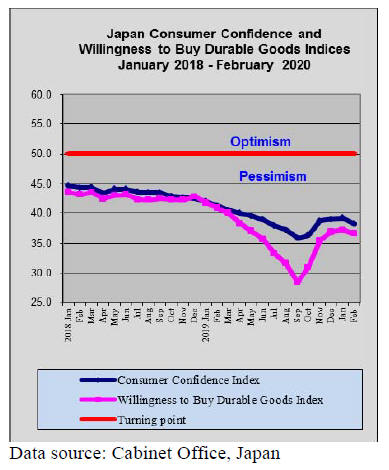
Bankruptcies rise for the first time in more
than a
decade
The research agency, Tokyo Shoko Research, has reported
that the number of corporate bankruptcies in Japan
increased in 2019 for the first time in 11 years. The agency
points to the combined impact of the 2019 consumption
tax hike, labour shortages and the spate of natural disasters
as drivers of higher bankruptcies.
It is reported that most companies filing for bankruptcy
were small firms with fewer than 10 employees. The
agriculture, forestry, fisheries and mining sectors were the
worst affected. Tokyo Shoko Research writes "Mediumsized
and small companies have been in a difficult
situation as the labour crunch has raised personnel costs
and squeezed profit margins.¡±
Yen see-saws, volatility could undermine export
competitiveness
The yen rose sharply against the US dollar in early March
rising to around yen 103 yen to the dollar, the highest
since November 2016.
The Ministry of Finance has raised concerns over the yen
volatility pointing out swings in exchange rates, either up
or down are undesirable. The fear among policy makers is
that a prolonged period of yen appreciation could
undermine export competitiveness.
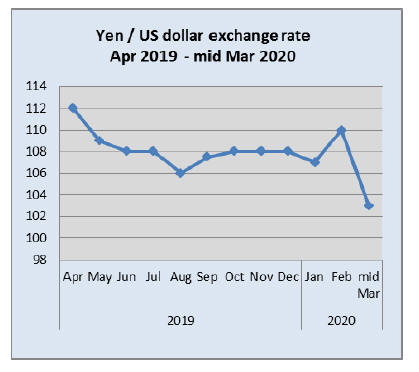
Firm demand for condos in Tokyo
Even before the corona virus outbreak construction
companies in Japan were finding it hard to attract workers
and had come to rely heavily on immigrant workers now
construction firms are faced with new problems of raw
material issues as supply chains are being disrupted by the
coronavirus outbreak.
According to the Land Institute of Japan in 2019 existing
condominium sales in Tokyo rose almost 2.5% while sales
of existing detached houses in Tokyo increased around
4.5% year on year. In contrast, housing starts in Japan
dropped in 2019.
February housing starts rose sharply month on month
largely because the weather improved allowing
construction work to proceed.
Year on year February starts were slightly higher. The
increase was driven mainly by construction of owneroccupied
homes and condominiums.
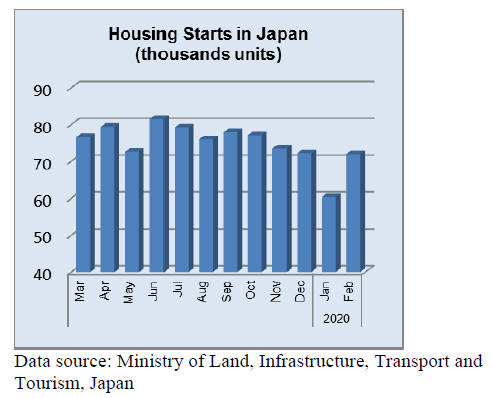
Import update
Long term furniture import trend
It will be seen from the graphic below that there has been
a steady decline in Japan¡¯s imports of wooden office
furniture. What comes as something of a surprise is that
the value of imports of both wooden kitchen and bedroom
furniture have shown signs of trending higher over the past
three years, even in the face of a weak housing market.
Some of the upward trend in kitchen furniture could be
explained by the growing interest in home renovation but
this does not explain the rise in imports of bedroom
furniture.
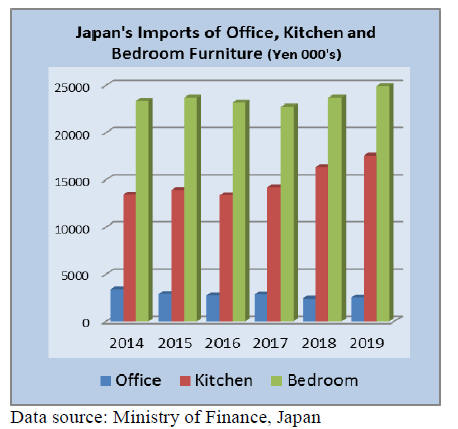 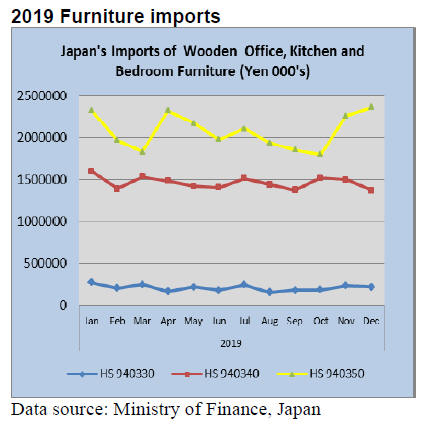
Office furniture imports (HS 940330)
Year on year Japan¡¯s December 2019 imports of wooden
office furniture (HS940330) were up 16% but compared to
the previous month December imports dropped 8%.
China, Poland and Portugal have been the top shippers of
HS940330 throughout 2019. In December shipments from
manufacturers in China accounted for over 70% of all
wooden office furniture imports.
Shipments from Poland, the second largest supplier in
December, accounted for just 6% of imports while the
third largest shipper, Portugal, added another 4%. In
December 2019 Italy was not a significant supplier.
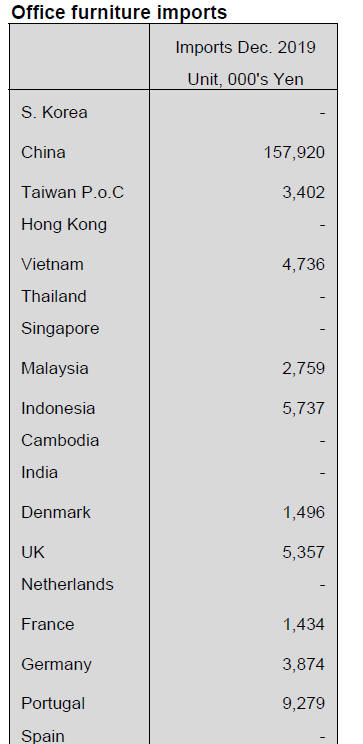 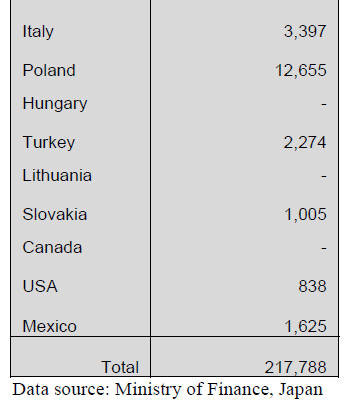

Exporters in the Philippines and Vietnam accounted
for
most of Japan¡¯s imports of wooden kitchen furniture
(HS940340) in December 2019, as they did for most of the
year. Shippers in the Philippines took 45% of import
demand in Japan with a further 37% being captured by
Vietnam.
Exporters in China accounted for just 11% of December
2019 imports of wooden kitchen furniture. The other
significant but small supplier was Thailand with a modest
3% share of December imports.
Year on year imports were down 11% and there was an
8% month on month decline in the value of imports.
Bedroom furniture imports (HS 940350)
Japan¡¯s imports of wooden bedroom furniture continued
higher in December 2019 building on the gains in the
previous month. The surge in imports of wooden bedroom
furniture at year end is a pattern repeating itself over
recent years.
Two shippers, China and Vietnam, accouned for over 90%
of Japan¡¯s wooden bedroom furniture imports in
December 2019 with Chinese shipper taking the lion¡¯s
share at 52%. The other shippers of note were Thailand
and Malaysia with around 2-3% each.
Year on year, December imports of wooden bedroom
furniture rose 17% and month on month there was a 4%
rise.
 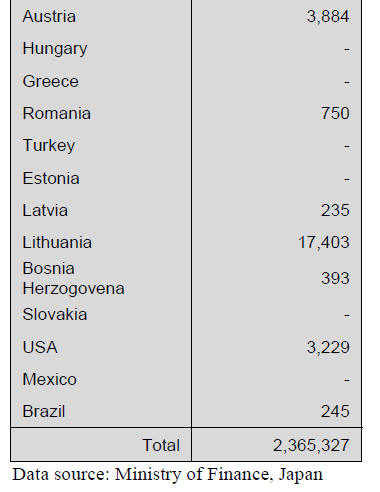
Trade news from the Japan Lumber Reports
(JLR)
The Japan Lumber Reports (JLR), a subscription trade
journal published every two weeks in English, is
generously allowing the ITTO Tropical Timber Market
Report to reproduce news on the Japanese market
precisely as it appears in the JLR.
For the JLR report please see:
http://www.nmokuzai.com/modules/general/index.php?id=7
Forest product trade of China in 2019
Despite trade war between China and the U.S.A., contrary
to the expectation that forest products trade of China drops
considerably in 2019, log import was only 0.9% less than
2018 and lumber import increased by 1.5%. This is the
second highest import.
Log imported volume was 59,133,000 cbms and lumber
was 37,165,000 cbms. Logs from New Zealand were the
highest with 17,735,000 cbms, 2.0% more than 2018 while
log import from other sources like Russia, U.S.A, and
Malaysia declined.
Russia was the top log supplying country but because of
high log export duty, it decreased by 28%. Logs from the
U.S.A decreased by 41% due to duty problem by the trade
war. Meanwhile lumber import from Russia was record
high with 18,340,000 cbms. Lumber from Canada
increased.
Plywood export by China was 10,176,000 cbms in 2019.
This year¡¯s problem is outbreak of corona virus disease,
which hampers smooth operation of wood products¡¯
supply chain by restriction of people¡¯s movement.
Delayed shipment of Chilean lumber
The second ship in 2020 of Chilean radiate pine lumber
will delay arrival to Japan by more than a month. Loading
in Chile will be middle of April so the arrival to Japan will
be late May or early June. The first ship will arrive in
March so there will be more than two months interval.
One of the reasons of the delay is restoration of stagnated
crating lumber market in Japan. The market in Japan has
been in slump since last year with stagnated movement
then the shipment to China also slowed down by recent
outbreak of corona virus.
The suppliers hope that the market in Japan would restore
and the inventories would be consumed during two
months interval. After the third ship, plan is to arrange
shipment with 50-60 days interval so total number of ships
in 2020 will be six as originally planned. The export prices
for the second ship are unchanged from the first ship with
about US$300 per cbm C&F on both thin board and
square.
As to higher ocean freight by costly low sulfur oil, the
suppliers plan to add little by little after the third ship if
Japan market recovers enough to accept extra prices.
2019 plywood supply
Total plywood supply in 2019 is 5,859,100 cbms, 4.6%
less than 2018. This is the first time that total supply
decreased less than six million cbms in three years. Both
production and shipment of domestic softwood plywood in
2019 recorded the highest. Meanwhile imported plywood
in 2019 is the lowest in last 20 years. In particular, the
supply from Malaysia dropped less than one million cbms,
the lowest in last 24 years since 1995.
Share of domestic plywood is 56.7 %, 4.3 points up. It
was 2016 when the total supply drooped under six million
cbms. In this year domestic supply exceeded 3 million
cbms and the imports was the record low and this is the
year that domestic share exceeded the imports for the first
time and the difference got larger last year.
Supply of imported plywood has been under three million
cbms since 2015 when the supply decreased from
Sarawak, Malaysia by environmental restrictions. The
supply decreased down to 2,700,000 cbms in 2016 then
over 2,900,000 cbms in 2017 and 2018 but in 2019, the
importers reduced the purchase by high export prices and
depressed market in Japan.
There are four months in 2019 with monthly arrivals are
less than 200,000 cbms so total supply dropped down to
2,535,000 cbms, 13.3% less than 2018. Supply from all
the major sources decreased. Malaysian supply was
874,900 cbms. Chinese supply was less than 600 M cbms,
the lowest in ten years. Indonesia supply was less than
900,000 cbms.

B.C. revises lumber export regulation
manufactured forest products regulation) since July 1,
2020 Maximum lumber size is changed from 17¡± square
to 12¡± square and also cross section of lumber of less than
0.2 square meters is revised to 0.1 square meters or less.
On red cedar and cypress (yellow cedar), export of only
finished products is allowed.
Purpose of these revisions is to increase more processing
and make value added products but industry people
comment that these are not realistic, particularly on red
cedar and cypress because exporting items are large
fitches, which are for re-sawing into smaller custom made
lumber in Japan.
If required condition is not satisfied, it is necessary to
acquire exemption certificate and pay compensation. This
is practically export duty.
Majority of main export items like SPF, hemlock and
Douglas fir from B.C. are satisfied with the conditions but
red cedar and cypress are hard to satisfy the condition.
Particularly cypress is processed into smaller order made
lumber in Japan from flitches so it is not practical to
export finished size.
General comment is that there is very little merit for
lumber industry in B.C. by this revision. There is more
than 20% duty for export to the U.S. market and value
added products are imposed higher duty.Also there are not
enough remanufacturing plants in B.C. and there is very
little company, which is willing to invest building for
remanufacturing facility.
Import of red cedar and cypress lumber for Japan from
B.C continues declining. In 2019, red cedar was 36,992
cbms, 13.3% less than 2018 and cypress was 33,927 cbms,
24.8% less. Together with declining demand in Japan,
supply side is also getting frail. Western Forest Products
continues more than seven months strike and Interfor
closed Hammond mill at the end of last year, which was
main red cedar lumber mill.
South Sea (tropical) logs
Supply and demand of South Sea hardwood logs are
balanced. PNG announced increase of log export duty
since February so higher cost logs will come in since
March.
Also quarantine is tightened after corona virus disease in
China and log ships need to call main port in PNG, which
increases sailing days and increases the freight. PNG log
users in Japan say that it is tough time to swallow higher
cost now. Production of Chinese made red pine free board
is practically stopped by the corona virus disease as
workers are ordered to stay home for two weeks.
Cedar lumber export to the US market
Kyowa Lumber (Tokyo) looked for a chance to export
Japanese cedar lumber to the US market since two years
ago and has shipped some to test the market since last
year. It studied quality the US market demands and
introduced special processing machines.
The orders have been increasing and now it ships about
1,000 cbms a month steadily. It intends to develop the
market in the US. with variety of items.
Japanese cedar has been used to substitute North
American red cedar, which supply keeps shrinking and the
prices are soaring. The demand has been expanding since
three to four years ago.
Japanese cedar looks the same as North American red
cedar but they are different so Kyowa has been
investigating if the substituting demand is real or not. It is
now convinced that there is certain demand and the market
should last longer.
The exported lumber is displayed at DIY stores in the
U.S.A. together with red cedar and redwood lumber.The
main size is 1x4-6 with length of 6 and 8 feet. It is rough
lumber. Kyowa introduced the same machine, which
manufactures fence lumber in the U.S.A.
The lumber is mainly used as outdoor fence and decking.
Kyowa thinks that the demand for lumber in Japan would
keep shrinking with depopulation in future so it needs to
look for outside markets.
Oshika developed lignin fenol adhesive for plywood
Oshika Corporation (Tokyo), adhesive manufacturer, has
developed lignin fenol adhesive for plywood
manufacturing. It has been testing this new adhesive at
Niigata Gouhan Shinko and has acquired JAS certificate
on January 7, 2020.
Lignin is one of ingredients wood contains with cellulose.
Softwood contains 25-30% lignin and hardwood does 20-
25%.When manufacturing paper and pulp, lignin is
removed and is used as fuel in the past. Meanwhile lignin
has function to glue fibers together.
Oshika has been studying for last ten years how to use
plant originated materials as adhesive since general trend
is to avoid using fossil fuels and it has been developing
environmentally friendly materials.
Lignin is procured from UPM Kymmene of Finland.
Kymmene has been manufacturing resin from renewable
materials like wood and anxiously developing biorefinery
business.
Lignin is blended with fenol resin and reacts with formalin
to make lignin fenol adhesive. Acquired JAS covers low
formaldehyde structural plywood, termite treated
structural plywood and standard plywood.
Review of 2019
There are two different pictures on plywood market. One
is booming domestic plywood and another is stagnant
market of imported plywood.
Total plywood supply in 2019 was below six million
cbms. Domestic plywood market continued briskness for
whole year.
Plywood market used to fluctuate so often and so much
that the manufacturers struggled to survive but in last four
years, the demand has been robust without much dip and
the plywood manufacturers have made full production.
Thus, both the production and shipment in 2019 was
record high.
Actually the shipment was so active that it often exceeded
the production and the inventory has been in very low
level like less than one month. There are two new plywood
mills started in 2019 and some feared over-supply when
they started but the market absorbed additional supply
without any problem.
Total supply of domestic plywood in 2019 was 3,324,000
cbms, 3.3 % more than 2018 out of which softwood
plywood was 3,200,000 cbms, 3.6% more while the
imported plywood was 2,535,000 cbms, 13.3 % less than
2018 so that the share of domestic plywood was 56.7%.
The market in the western Japan in the first half of the
year was busy by restoration demand for flood and land
slide damages caused by typhoons in 2018. In the Eastern
Japan, the market softened when two new plywood mills
started in fear of over-supply so the market prices
weakened.
The manufacturers¡¯ proposed prices were 1,050 yen per
sheet of 12 mm thick 3x6 panel but the prices in the
market dropped down to 1,000 yen or less so in May
Seihoku group stepped up to correct extreme low prices in
the market because the manufacturing cost has been
climbing particularly transportation cost by shortage of
truck drivers. Then the demand recovered in the second
half of the year.
In September and October, series of typhoons hit the
Eastern Japan and caused flood by heavy rain and many
houses were damaged by extreme strong wind so
emergency demand for temporary repair of roof and floor
arose so the busy demand lasted through December.
Material logs like cedar and cypress are readily available.
Domestic species used to be used for construction but
nowadays, major members like post and beam are replaced
by the European laminated lumber and KD Douglas fir
lumber so major users are now plywood mills. With
continuous full production of plywood mills, there is not
any serous log supply shortage.
Market of imported plywood in Japan has been sluggish
all through the year with the prices lower than future
purchase prices.
The arrivals were record low in last twenty years. In
particular, the supply from Malaysia was less than
1,000,000 cbms, the lowest since 1995.
Plywood manufacturers in Malaysia and Indonesia
struggle to survive with climbing log cost and labor cost.
They are forced to propose higher export prices to pass
such high manufacturing cost and many have to curtail the
production as Japan market cannot pay high export prices.
In last June, log supply increased temporarily and log
prices dropped so that the export prices of 3x6 concrete
forming panel dropped from US$680 per cbm C&F to
$630 in late August and the market prices in Japan
dropped much more than export prices.
Log prices soared in September before rainy season and in
October, Shing Yang, the largest Malaysian plywood
manufacturer reduced number of employees and curtailed
the production. This is not temporary measures but
permanent down scaling.
The market in Japan finally rebounded after bottoming out
in October but the demand of end users continues dormant
so it looks hard to bring the prices up to level of high
export prices.
Outlook of 2020, Domestic plywood
Pattern of plywood market is that the demand keeps busy
through February by carried over orders of precutting
plants then in March, the market confuses by inventory
correction as it is book closing month and the market is
not stable until the fourth quarter when the demand firms
up but there are some uncertain factors this year.
One is restoration demand for last year¡¯s typhoons¡¯
damages, which is much larger than 2018¡¯s western Japan
damages. Structural plywood should move for repair
works so it depends on how much such demand occurs in
2020.
Another factor is the Tokyo Olympic Games in summer
when there are traffic restrictions around Tokyo.
Construction works will be largely affected by this so
construction schedule may be postponed after the Olympic
Games.
On supply side, there has been strong demand for nonstructural
plywood like floor base but so far, the
manufacturers are busy to manufacture structural panels so
when the demand of structural plywood weakens, the
manufacturers reduce production of structural panels and
shift to produce more non-structural panels like floor base.
Imported plywood ¨C Market environment of imported
plywood continues severe.
The importers are not placing enough volume since the
export prices are higher than market prices in Japan so
monthly arrivals continue dropping month after month.
The manufacturers in Malaysia and Indonesia are
determined to pass high cost onto export prices and if
Japan cannot accept, they would further curtail the
production by laying off workers.
Log cost stay up high, minimum wage of workers is
increasing and ocean freight is climbing by higher cost of
fuel so further increase of export prices is inevitable.
The market in Japan is not strong enough to follow such
high prices so this year is turning point for imported
plywood in Japan market.
Due to shortage of virgin timber, the manufacturers have
started using planted species like falcate and eucalyptus
for plywood manufacturing but this is different from
traditional tropical hardwood plywood so replacement is
not easy.
|